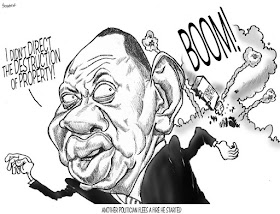Pastor Victor Kanyari is a name that will be instantly
familiar to many Kenyans. He rocketed to national infamy when he was caught on
camera relieving thousands of faithful of their hard-earned money under the
pretext of interceding with the Almighty on their behalf. The scam asked
gullible people of faith to “plant seed” by contributing about $3 to his
“ministry” in return for which they could expect miraculous answers to their
prayers. Pastor Kanyari was caught on camera recording fake call-in radio shows
and performing equally fake “miracle cures” at his church in downtown Nairobi.
Despite all this, he is still a free man and no charges have been filed against
him. According to a prosecutor with the Office of the Director of Public
Prosecutions, the video recordings did not constitute evidence of wrong doing
and other witnesses were unwilling to testify against the Pastor.
The Prosperity Gospel
articulated and exploited by the likes of Kanyara, and many other millionaire
preachermen and preacherwomen in Kenya and across the globe, emphasizes a
radical Christian religious doctrine that financial blessing is the will of God,
and that faith, positive speech, and donations will increase one's material
wealth (and restore physical health). Rising out of the US in the 1950s, it has
spread across the globe with startling speed, spawning thousands of extremely
wealthy pastors, if not exactly wealthy congregations.
However, the Christians were not the first to come up with
this scam. In Kenya, our politicians have long perfected a version of it. What
they promise is something called development in return for which we must seed
their pockets with our taxes.
I have written before about this religion
of development, Kenya’s very own National Prosperity Gospel which requires
that citizens focus of the outward manifestation of development, not the
substance of it. For example, at independence, an in common with other African
nations, we focused on prestigious, highly visible “development projects” at
the expense of much more modest interventions that would have generated greater
benefits for the people. So we built highways and hospitals in the cities where
the elite resided and all but ignored the rural areas where most Kenyans eked
out a living.
Today, the Gospel is evident in the fact that we continue to
invest in railroads and laptops we don't need, in fire
engines and ambulances we don't or can’t
use, and in expensive kit for police we have failed to reform. Today our "seed"
will pay for laptops but not teachers, for ambulances but not doctors and
nurses.
Sadly, ours is a desperate, gullible country with blind
faith in the words and actions of development priests and charlatans. And when
the promised benefits inevitably fail to materialize, it is the citizens, the
believers, who are to blame for a deficit of faith. Those who dare raise a
complaint are accused of a debilitating negativity that sabotages
the economy. We are urged to embrace positivity. “Have more faith! Send
more seed! The miracles will come,” we are exhorted.
Planting this seed requires us to provide our political
priests with big salaries, cars and mansions, as well as opportunities to “eat”.
When they prosper, the National Prosperity Gospel teaches, we have a vicarious
share. However, more is required. We must also turn a blind eye to their
thieving ways. Not ask uncomfortable question why, like Kanyari, no one is ever
held to account when the promises of safety and prosperity turn out to be
mirages.
During his recent visit, President Kenyatta requested Pope Francis
to pray for his efforts to fight corruption. Which would have been fine if his
administration were actually trying to root out the vice. He has recently
announced the formation of an Asset recovery unit in the Attorney-General’s
office but says nothing about recovering the over $1 billion in assets belonging to
members of the Moi kleptocracy identified by the
Kroll report over a decade ago.
Instead, he last year personally OK-ed the release of 1.4 billion shillings to
shell companies associated with the AngloLeasing scandal. He said it was
necessary to do this in order to secure the Eurobond, whose proceeds his
government cannot account for today. But no one saw fit to remind the Holy
Father of this. Keep the faith, are urged.
There is similar rhetoric on security and terrorism, where
the government is unable to articulate the specifics of what lessons it has
learnt from previous terrorist attacks and cannot be bothered to counter statements
by senior police officers that it has in fact learnt nothing. Persistent
and credible allegations that KDF officers across the border are engaging
in illegal smuggling activities that benefit Al Shabaab are similarly given
short shrift. Just have faith we are told. Blessed is he who does not see, yet
believes.
Yet blind faith in government, or indeed anything or anyone,
is a particularly dangerous pursuit. Kenyans must reject the National
Prosperity Gospel. Development and riches will not come from having faith the
likes of Kanyari and his ilk in government, but through critically and honestly
evaluating and then addressing the reasons for our poverty. And demanding proof for the things we are
asked to believe.







